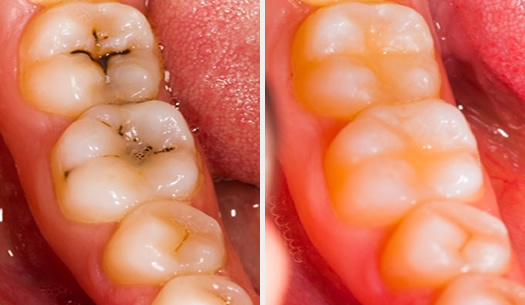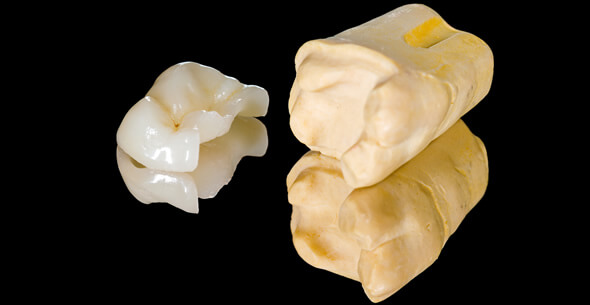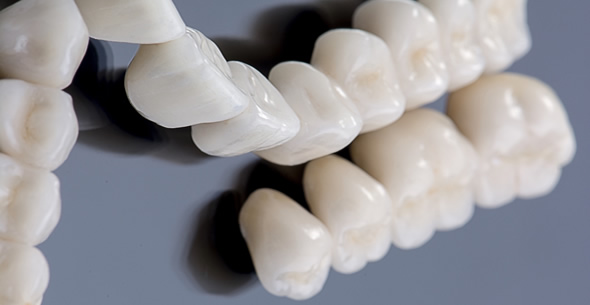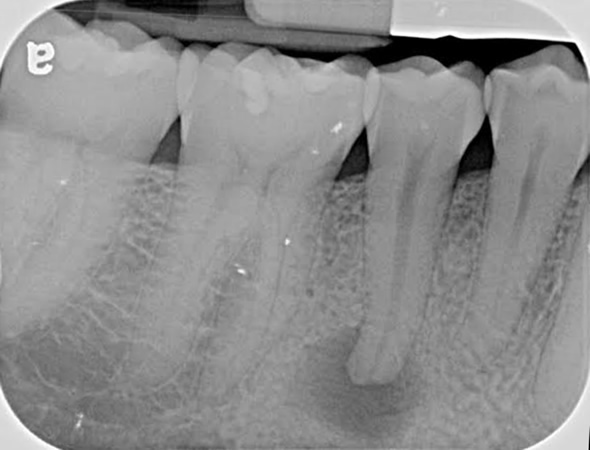Restorative Dentistry
Restorative dentistry is the management of oral health problems and the restoration of functional and aesthetics of the dentition.
The goal is to bring back your natural smile and function, and prevent future oral health issues.

White Fillings
White Fillings or Composite Fillings

Fillings are the most common type of 'restorative treatment' for damaged teeth.
A filling replaces the part of the tooth that has been lost as a result of tooth decay or because the tooth has broken. One option in restoring the tooth is to have a white filling, commonly known as a ‘Composite Filling’.
White, or tooth-colored, fillings have been a preferred method of dental bonding for decades. These fillings are an excellent option for filling a small cavity, replacing a small old mercury or composite filling, and repairing an otherwise healthy but broken tooth.
After the decayed area of your tooth has been removed, white fillings are fitted which are made from a compound of glass or ceramic materials plus resin. The colour of these fillings can be matched closely to the natural colour of your teeth, ensuring they are highly discreet.
Just like your natural teeth, white fillings can stain over time, so your dentist will give you appropriate aftercare advice.
When the cavity or old filling is large, especially when more that 60% of the natural crown structure is damaged, or has cracks or fractures, or if there are heavy chewing forces on the tooth, we look at porcelain fillings as a better option than dental bonding.
Porcelain inlays, overlays and crowns (depending on the size of the defect in the tooth) are much stronger and longer lasting than white fillings.
How long any filling will last depends on such factors as how well you look after them, how large they are, how strong your biting forces are on restoration.
Inlays / Onlays
Porcelain Inlays and Onlays

Inlays and Onlays are porcelain fillings that are stronger and longer-lasting alternatives to white fillings.
These types of tooth restorations are ideal for when a tooth is cracked, or an large old amalgam filling is leaking or failing.
This is a 2-visit procedure - the first to prepare the tooth surface and the second to fit the Onlay / Inlay.
The Procedure
At the first visit, we remove the unhealthy part of the tooth, whether that is decay, old mercury fillings, cracks, etc. We try to only remove affected tooth structure and save as much healthy tooth structure as possible. We then take a impression of the prepared tooth and our ceramic technician creates a beautiful porcelain filling to fit your tooth perfectly.
Your second visit will follow after a couple weeks, and at this appointment we will bond the porcelain inlay or onlay to your tooth. Once your inlay or onlay is bonded in place, your tooth will be stronger than it was before and it will be able to bear up to 75% more chewing force then with normal white fillings.
Crowns & Bridges
Crowns and Bridges

A dental crown is a full porcelain restoration used to replace or strengthen our tooth structure.
A dental bridge is several crowns bonded together, carried by natural teeth or implants to replace missing teeth.
Please visit our page on Crown & Bridge Work for full details about what we do at Durrheim & Associates.
Root Canals
Root Canal Treatments
This dental procedure is carried out when the innermost part of the tooth ‘the pulp’ becomes badly decayed or infected. If left untreated, the tooth will begin to die which could lead to the loss of the tooth. To save the tooth, the infected pulp needs to be removed to prevent the formation of an abscess. In dental terms this procedure is called ‘Endodontics’.
After a root canal is successfully done, a porcelain crown should be considered, as this will help prevent the tooth from fracturing. This is especially helpful if a large restoration was originally done, with not much tooth structure left to work with.
The tooth is made up of:
- Enamel – The hard outer layer of the tooth.
- Dentine – This forms the core and gives the basic shape to the tooth which supports the enamel, it is softer than enamel but harder than bone.
- Pulp – Is the central part of the tooth which contains nerves and blood vessels and lies within the root canal.
The reasons why the pulp would die:

- Carie - If caries 'decay' is left it will travel through the enamel and dentine down into the pulp chamber.
- Trauma - A severe knock that affects the pulp.
- Severe Gum Disease - The gum detaches itself from the tooth creating a gap between the tooth and the gum, bacteria then gets trapped causing an infection which can infect the pulp.
(Photo shows an abscessing tooth with destroyed bone around the root tip.)
- Carie - If caries 'decay' is left it will travel through the enamel and dentine down into the pulp chamber.
The symptoms:
- Pain – This can be anything form a constant dull ache to severe pain or pain only when biting
- A spot sometimes appears on the gum in the area of the infected tooth, this is where the collection of puss from the root tip is draining which will leave a bad taste in your mouth.
- Swelling in the gum area surrounding your tooth
- Often no pain
On your initial appointment the dentist will locate the offending tooth and take an x-ray in order to show the roots of the tooth, to see how far the decay has travelled and if there is an abscess present. A course of antibiotics may be given to clear the abscess before the treatment is started as the abscess will reoccur if the treatment is NOT carried out.
The first appointment
- The dentist will give you a local anaesthetic to numb the tooth and the area surrounding it.
- The tooth will then be isolated from the rest of your teeth.
- Your dentist has to gain access to the pulp chambers, this is done by removing the filling or decay.
- Once access has been gained to the pulp chambers the dead pulp is removed from the root canals. An additional x-ray will be taken at this point.
- Once the root canals are cleaned the dentist will place a medication to help clear any bacteria. The tooth will then either be temporarily filled and another appointment required or if the infection was not too serious, the tooth can be filled permanently and your treatment complete.
- The tooth may feel tender for a few days and you may need to take pain killers.
- It is possible, at this stage, that the abscess can get worse.
If a second appointment is necessary
- You will be given a local anaesthetic to numb tooth and the surrounding tissue
- The dentist will continue cleaning out the canals using the same process as before. Once the canals are clean and dry they will be filled with a material called ‘Gutta Percha’ which is placed into the root canal until it is sealed.
- An X-ray is then taken to check that the canals have been filled completely.
- A permanent filling will then be put in place.
- Your dentist may advise you to have a crown placed on the tooth to strengthen it.
Dentures
Dentures and Partial Plates
Dentures and Partial Plates is one of three ways to replace missing teeth in the dentition.
Impressions of the upper and lower dentition is made and models are casted.
The next step is planning the denture or plate. We have mainly three types of plates namely, Valplast plates, Acrylic plates or Chrome Cobalt plates. Chrome plates are the best and most comfortable type of plates.
